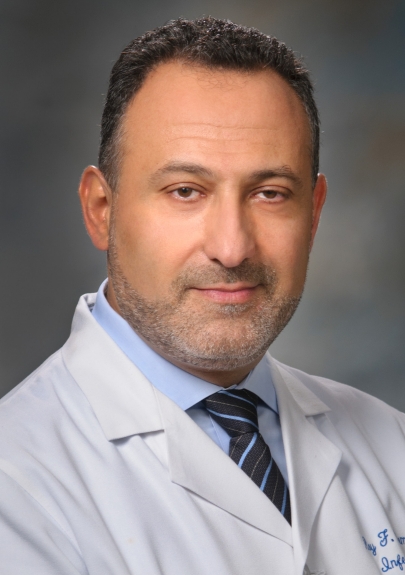April 2018
Virologist Roy Chemaly is helping to protect people with cancer against the threat of flu.

By Daniel Oppenheimer
Editor, Texas Health Journal
If it’s flu season, and patients at The University of Texas MD Anderson Cancer Center show even the slightest signs of possibly having the virus—a cough, a runny nose, a sore throat—clinicians don’t wait for test results. They administer Tamiflu, an antiviral medication that can shorten the duration and limit the severity of the infection.
“Prompt initiation makes a big difference with outcomes in cancer patients,” says Dr. Roy Chemaly, a professor in the Department of Infectious Diseases. “If you start early treatment, within 48 hours of contracting the virus, you can prevent progression to pneumonia and even death.”
This protocol at MD Anderson is in place thanks in part to Chemaly, who studies the intersection of cancer, cancer treatment, and community-acquired respiratory viruses (CRVs) like influenza, respiratory syncytial virus (RSV), and parainfluenza virus (PIV).

Dr. Roy Chemaly, Professor, Department of Infectious Diseases, Infection Control and Employee Health, Division of Internal Medicine, The University of Texas MD Anderson Cancer Center
The rapid initiation of antiviral treatment isn’t the only thing that MD Anderson does to protect its patients from flu and other CRVs. Through a combination of policy changes and awareness campaigns, they’ve brought up the rates of flu vaccination among their own providers from 56% to 97% in less than a decade. They closely monitor patients’ vaccination status and encourage vaccination when appropriate, as it is for most patients who aren’t severely immunocompromised. Recently, MD Anderson became the first hospital in the nation to routinely disinfect some patient rooms with ultraviolet light.
When Chemaly was hired by MD Anderson, in 2002, this kind of intensive focus on viruses and cancer wasn’t the norm. In fact, he was one of the only virologists on the infectious diseases team.
“Until maybe 15 or 20 years ago, the perceived threat from infection in the cancer field was almost entirely focused on the risks of bacterial and fungal infections,” he says.
“We didn’t realize how often viral infections were playing a role in bad outcomes.”
Much of Chemaly’s research has focused on establishing a foundational evidence base for the interplay of CRVs and cancer. That includes a variety of studies analyzing flu risks among patients with various types of cancer, particularly what are known as hematological malignancies—cancers like leukemia and lymphoma that affect the blood and lymph systems. He has also done a lot of work on the benefits of vaccination and antiviral treatments, and on the potential benefits of new treatments.
A 2006 paper, for instance, looked retrospectively at the outcomes in a small group of 33 leukemia patients who got the flu. Of the eight people who weren’t prescribed a neuraminidase inhibitor—which is now a common class of antiviral drugs that includes Tamiflu—three died from influenza-related pneumonia. Of the 25 who did receive one of the drugs, none died.
It was a small, preliminary study, and Chemaly and his colleagues were cautious not to oversell its implications. In retrospect, however, it was part of a much larger wave of research into the dangers of flu, and the potential benefits of antiviral drugs, that has changed the practices in the cancer field.
Other work by Chemaly and colleagues has looked at the potential benefits of early antiviral treatment in hematopoietic cell transplant (HCT) recipients; compared outcomes in children with cancer who got the seasonal flu, in 2009, to those who got the pandemic H1N1 flu; and evaluated the efficacy of a “pulsed xenon ultraviolet disinfection system” in killing bacteria in operating rooms.
For the most part, it has been slow, steady, incremental work. Some of the most important research has involved documenting what, in retrospect, seems as though it should have been obvious—that common viruses can be acutely dangerous to patients with cancer. And some of the most important interventions are about changing cultures and habits rather than discovering new therapies or procedures.
“My goals before I retire are two things,” says Chemaly. “First, I want to bring new treatments for viruses to our cancer patient populations. We have some good treatments for influenza, but there is nothing out there for many other viruses. Second, I want us to get to the point where hospital-acquired infections are almost unheard of. It will be difficult, but we are trending there.”
The first goal is one that Chemaly has already met, in part, when FDA approved Prevymis, a new drug he helped develop, last November. Brought to market by Merck, it has been shown to help prevent infection from cytomegalovirus (CMV), a common virus that isn’t particularly dangerous for people with healthy immune systems but can be life-threatening for many patients who are undergoing hematopoetic cell transplantation.
The second goal will be a longer-term one, says Chemaly, that will require more of that slow, steady, incremental work. Even more comprehensive vaccination of employees and patients. Quicker diagnoses of infections. And more effective antiviral treatments, so that viruses that are brought in to the hospital are killed or contained as quickly as possible.
“There is no silver bullet,” he says. “It is a multidisciplinary team, multiple interventions, and bundle approach.”
